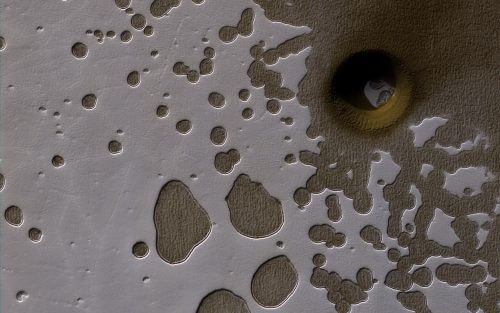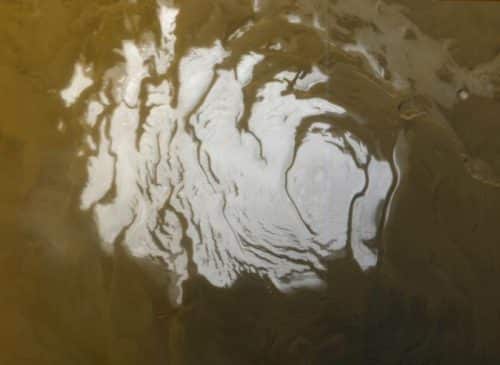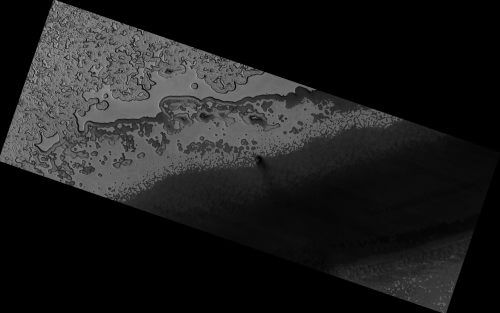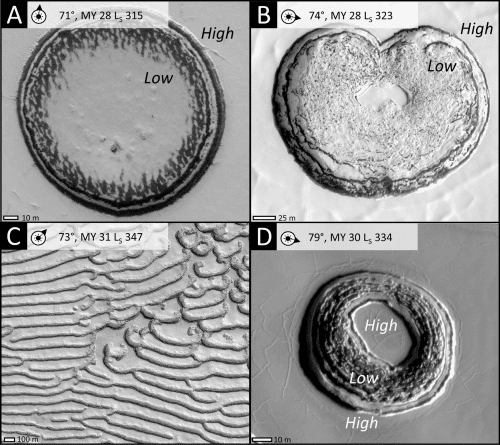A new photograph published by NASA reveals many pits and depressions in a layer of ice made of carbon dioxide at the planet's south pole. How are these pits formed, whose special shape gave them the nickname "Swiss cheese route"?

In a new and beautiful photograph, the American space agency Has released At the beginning of the month, see "Swiss cheese" route, a name given to depressions and pits that scar a layer of carbon dioxide ice (CO2), also known as "dry ice", which is at the South Pole of the Red Planet.
The photo also shows a deeper and larger pit on the upper right side of the photo. NASA researchers not sure Regarding its origin - it may have been created by an asteroid impact, or by collapse as a result of the sublimation (elevation) of carbon dioxide ice - a process of direct transition from solid to gas (residues of carbon dioxide ice can be seen at the bottom of the pit).
The photo was taken on March 25, 2017 by “The compass to survey Mars(MRO, short for Mars Reconnaissance Orbiter), a NASA spacecraft that has been in orbit around Mars since 2006. To photograph a resolution of 50 centimeters per pixel, and it was carried out by the telescope camera of the spacecraft, known as HiRISE (short for High Resolution Imaging Science Experiment). .

To understand how those "Swiss cheese holes" are formed in the dry ice, we must first understand how the poles of Mars behave, and especially the south pole, where only those strange holes are visible.
Mars, like Earth, has ice caps at its poles. The ice consists of a central layer of water ice, but in winter it is covered by a thin layer of carbon dioxide ice - dry ice (Mars has similar seasons to Earth, becauseThe inclination of the axis of rotation His is 25 degrees, slightly more than Earth's). The source of the seasonal dry ice is the thin atmosphere of Mars, which is made of 95% carbon dioxide. In winter, the temperatures are at the poles falling down Below minus 125 degrees Celsius - a temperature where CO2 Freezes and sinks to the ground, in a blanket of frost about one meter deep. With the coming of spring, the carbon dioxide turns into a gas and disappears back into the atmosphere.
This phenomenon of seasonal dry ice occurs at both poles, but at the South Pole is added another phenomenon of a permanent carbon dioxide ice layer, which remains in all seasons of the red year. It covers the water ice layer, andIts depth reaches up to about 10 meters. Its existence is possible thanks to the fact that the south pole of Mars is colder than the north pole, andeven in the summer The temperatures are low enough for carbon dioxide to remain in a solid state.

The "Swiss cheese" holes, according to the researchers, are created as a result of sublimation of the permanent dry ice layer - solid carbon dioxide that turns directly into gas. The depressions reach a depth of up to about 10 meters, that is, to the layer of water ice below the layer of dry ice, and their size ranges from tens to hundreds of meters.
The pits and depressions develop slowly, during the summer, due to heating from the sun's radiation. In summer, the sun appears very low in the sky in the polar region, and its rays strike them at an oblique angle. In this way, the areas that receive most of the radiation are the steep walls of the pits, so that they develop mainly to the sides, and less to the depth.
The nickname "Swiss cheese" may well fit the round pits in the new picture, but the sockets appear in many and varied shapes - some are almost completely round, some have asymmetrical shapes like a heart, and some are winding and narrow like snakes.

Multi-year observations by the MRO probe and the first probe to discover and study them, Mars Global Surveyor (operated between 1996 - 2006), allowed the researchers to identify annual development in the depressions. they appreciate that the depressions and pits expand at an average rate of about 3 meters per year, and in some parts the rate can increase to 8 meters per year.
This rate may sound rather slow, but what it means is that over geological time, the permanent ice sheet of carbon dioxide Was supposed to disappear completely. However, the existence of smooth and not scarred areas in the pits, indicates an opposite process of renewal of the dry ice layer, and its transformation into a stable phenomenon.
Existing climate models of Mars Can't explain the formation of a permanent CO ice layer2 at the south pole. The researchers hope that the prolonged observations of the MRO probe will allow them to understand not only the dynamics in which the depressions and pits develop, but you too The atmospheric processes in which carbon dioxide is trapped and released from the polar ice, and the history and evolution of the climate on Mars.

5 תגובות
In any case, this means that liquid water could not have existed there even in the very distant past, and life could not have existed there - because if there were water and plants, oxygen would have been created and then it would have been even colder there, if today it is already minus one hundred degrees, then what is life looking for there at all?
There are signs of erosion in the rocks there that are attributed to liquid water, but maybe what flowed there was liquid nitrogen or liquid oxygen or ammonia and not water.
So if in the future humans settle on Mars, (perhaps in caves like in the movie Fateful Memory), and start emitting oxygen there into the atmosphere, there will be a melting effect there (the opposite of a greenhouse effect).
Mars has a greenhouse effect, but its atmosphere is very thin - the atmospheric pressure is less than one percent of that of Earth, so the effect of carbon dioxide there is very weak.
See the extension here: http://sciencing.com/mars-greenhouse-effect-1914.html
And an article I wrote some time ago on a related topic: https://www.hayadan.org.il/curiosity-rover-add-to-a-mystery-that-concerns-mars-researchers-for-years
If their atmosphere there is made of 95% carbon dioxide - how come there is no greenhouse effect there?
"The photo was taken on March 25, 2017... and it was taken by the telescopic camera"
The photo was not "taken". It's done, and it's better photographed
In Hebrew you don't "take" photos